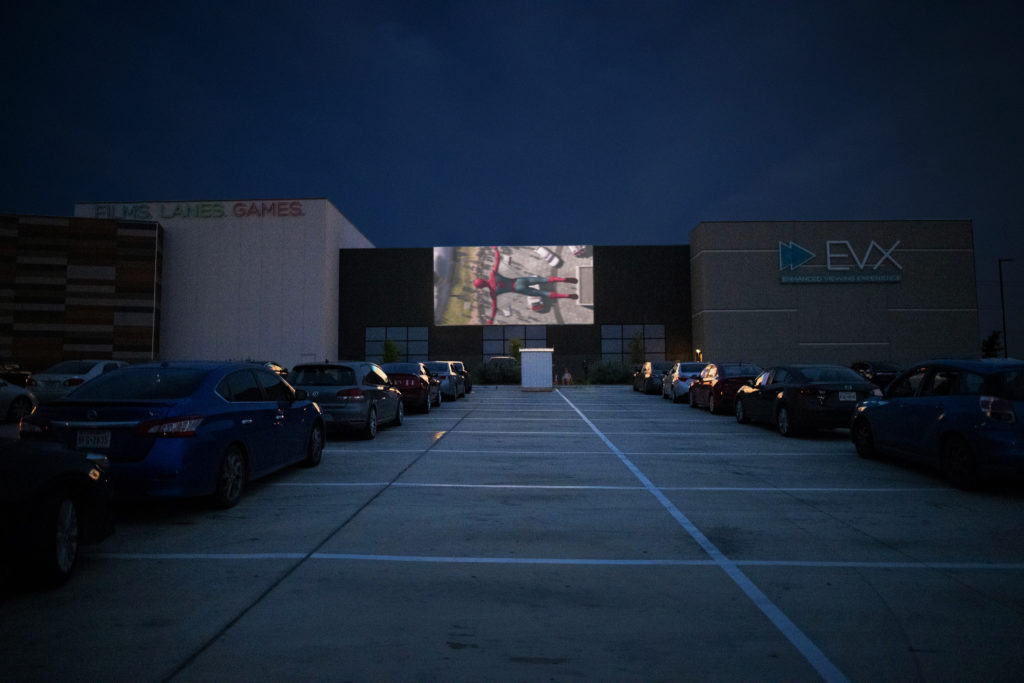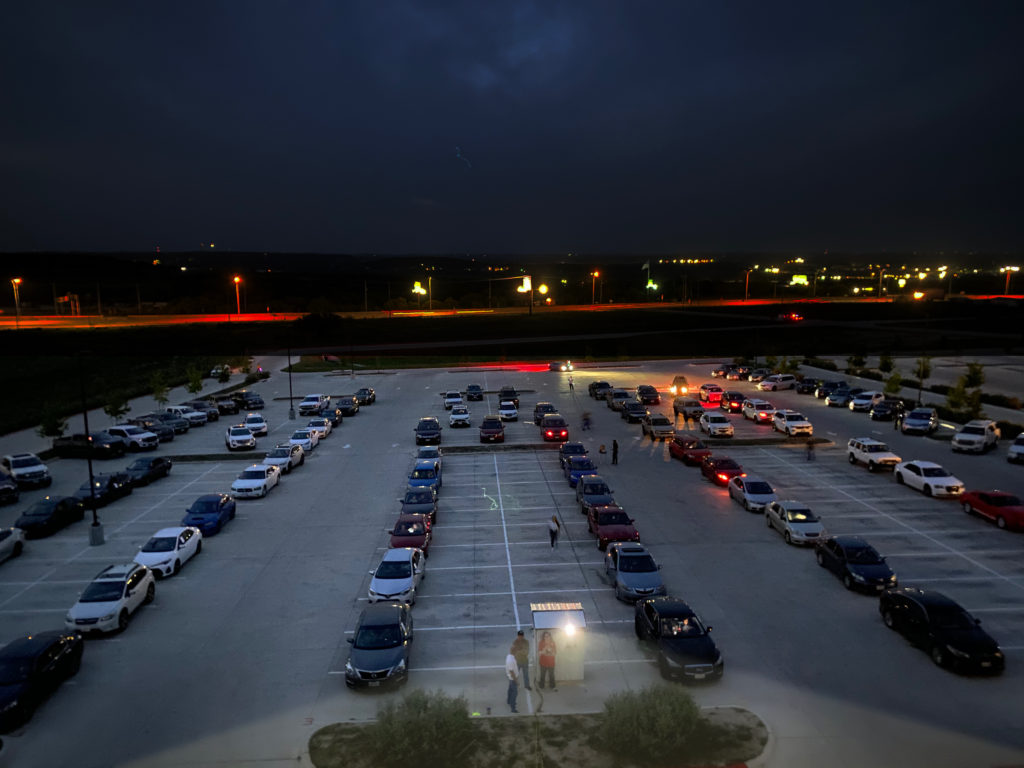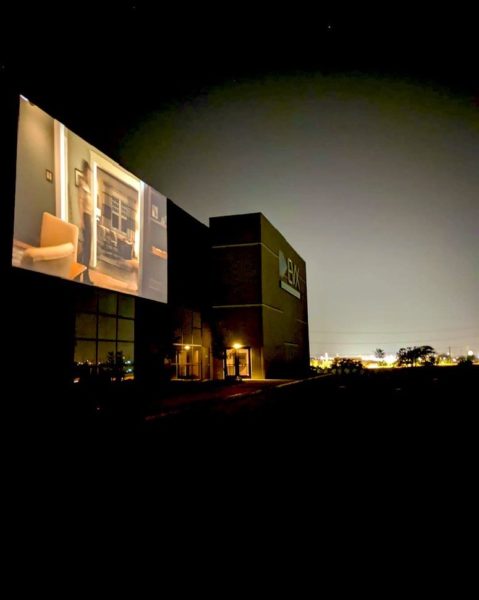With most U.S. theaters remaining shuttered due to the novel coronavirus pandemic, exhibitors nationwide have been crafting innovative solutions to keep their businesses afloat during the shutdown. For some, like the Florida-based chain Epic Theatres, those solutions have included temporary—and often highly improvised—conversions to the once-voguish drive-in format.
“We pulled an old screen out of storage and built a frame from PVC pipe, [then] hung the screen over the side of our largest auditorium wall,” says Epic Theatres co-owner and IT director Weegee DeMarsh, who, along with his brother and co-owner Joe DeMarsh, opened a pop-up drive-in at Epic’s Deltona location on March 20. Though they were later forced to remove the screen due to looming summer rains, the DeMarshes didn’t let that stop them. In a decidedly makeshift but highly effective solution, they proceeded to paint the auditorium wall white.
“That has worked out nicely,” says Weegee. So nicely, in fact, that Epic has since duplicated the formula at its Clermont and St. Augustine locations.
Though drive-in conversions remain exceedingly rare—indeed, many U.S. states won’t allow them during the pandemic—as struggling theaters scramble for ways to generate revenue amidst the unprecedented shutdown, their implementation has become increasingly common.
That said, pop-up drive-ins (as they have come to be known) aren’t a feasible solution for every theater. In addition to the often-insurmountable financial costs involved in setting them up, there are logistical considerations to account for. As Entertainment Supply & Technologies’ vice president of technology sales Scott McCallum tells Boxoffice Pro, the close proximity of many theaters to shopping centers and other businesses that utilize bright, automatic security lights after dark can make operating these ad hoc drive-ins an all but impossible challenge.
“Light and outdoor movies are not fans of one another,” says McCallum, who is currently assisting a number of theaters with drive-in conversions. “And that becomes a challenge if you’re a theater in a shopping mall. You know, you’ve got all the ambient light around. Or if you’re next to a car dealership, or whatnot. Traditional drive-ins have been in a remote area on the outskirts of town.”

For theaters looking to hire out companies like Entertainment Supply & Technologies for their drive-in conversions, the cost can be prohibitive. The FM broadcast equipment required to play sound through hundreds of car speakers can run between $5,000 and $10,000, says McCallum. Add a projector into the mix, and you’re out another $6,000 to $7,000. For those who request the full package—including proper screens, metal frames, servers, sanitary products, and more—the cost could run anywhere between $50,000 to $100,00 at the high end, according to informal estimates provided by McCallum and Alex Younger, CEO of cinema solutions company CES+.
In the event a theater decides to move forward with a conversion, time can also become an issue, says Younger, who as of last week had sent out 11 pop-up drive-in proposals to theaters in both the U.S. and Latin America.
“Some of these factories, they’re closed too, so it [becomes] a supply chain game where, what can we count on from the vendors?” says Younger. “It’s difficult to move and operate. We’ve run into those hiccups where [suppliers say], ‘Oh, I don’t have product.’”
With theaters looking at a potential delay of weeks, if not months, due to supply chain issues, cinemas—particularly those operating in colder climates—may already be running out of time, says Younger. “In some cases,” he adds, “we [may have] to develop our own equipment to sell to them.”
Even once a conversion is completed successfully, there are a variety of other issues to contend with. During a pandemic, safety is a paramount concern, and each drive-in is forced to follow guidelines set down by state and local officials. Eric Hansen, a consultant who has assisted with makeshift, low-cost drive-in conversions at Aspen Cinemas in Evanston, Wyoming and Water Gardens Cinema in Pleasant Grove, Utah (both of which cost in the $2,000-$3,000 range), says regulations can often be strict.
“When we first announced this thing, we wanted to make sure that we had all of those things kind of ironed out,” says Hansen, who notes that each of the two theaters he works with typically dedicate “one or two” employees to parking lot supervision. “If you go to the Evanston [theater’s] website, they have a drive-in information page that’s dedicated to all of the rules. We are pretty strict with all that. You know, you have to stay in your car. You can’t get in the bed of your truck, you can’t open the hatches of your vehicle, things like that.”
These restrictions can make all-important concession sales into something of an ordeal. Hansen notes that while both the Evanston and Pleasant Grove drive-ins have set up concession systems via an online store—through which customers can place orders for snacks before texting a dedicated phone number to indicate where they’re parked—food deliveries (handed out driver-side by employees outfitted in masks and gloves) can take a long time to get to customers. That can lead to some frustration on the part of both customers and employees.
“On our busy days, it takes a little bit longer because of the logistics behind it all,” says Hansen, who pauses before continuing dryly: “We’ll be grateful when we don’t have to do that anymore, let’s put it that way. It’s kind of a pain.”
Another significant issue to consider is how best to provide bathrooms for customers in a time of physical distancing mandates. While both Hansen and the DeMarshes tell Boxoffice Pro they’re offering access to their theaters’ indoor bathrooms during screenings, only one group or individual is allowed in at a time, and six feet of space is mandated between each person or group waiting in line. That can result in longer wait times for facilities.
Parking lot sizes are also an important factor to consider for theaters mulling a conversion. Some, like all three Epic Theatres locations, can accommodate only small crowds (the Deltona and St. Augustine locations fit only 113 and 75 cars, respectively). Others, like EVO Entertainment Group’s locations in both Schertz and Kyle, Texas (both of which reopened indoor operations with a limited capacity on Monday, May 4 while continuing to operate their pop-up drive-ins) get more bang for their buck; the Schertz location alone has managed to accommodate nearly 1,600 vehicles for a single showing.

While the logistical component of setting up drive-in conversions has presented a number of hurdles, once installed, the concept has been taking hold in many communities—not only providing out-of-home entertainment for the quarantined populous, but allowing theaters to keep employees on staff. (Hansen tells us the Evanston and Pleasant Grove theaters have actually hired extra staff to deal with the extra, pandemic-compounded burdens that stem from the drive-in format.) EVO notes that several of its drive-in screenings have been complete sell-outs, leading the company to ponder keeping them in operation even once the pandemic has subsided.
“We see the EVO Drive-In concept as becoming a regular component of our alternate programming, even after the environment shifts back to normalcy,” says EVO Entertainment Group CEO Mitchell Roberts, who says the only outside equipment the company purchased for their conversions were FM transmitters (everything else was either custom-made or came from in-house). “However, our primary focus will be reopening our in-venue experiences and implementing our new operating plans with enhanced safety measures.”
As Roberts indicates, these conversions may not be the future of moviegoing in the U.S., but drive-ins (both pop-up and traditional) are in higher demand than they have been in decades—and they could stick around beyond the scope of the pandemic, particularly if fears of contagion continue to linger. As McCallum notes, drive-ins showing retro content licensed from the studios—popular titles include such films as Back to the Future, Jurassic Park, Harry Potter, Jaws, and Grease—can also offer a nostalgic pull for some, adding an extra layer to the experience.
“I think people will remember when they were kids going to the drive-ins,” he says. Still, in his estimation, their appeal will remain limited if studios’ theatrical release slates remain empty throughout the summer season—and perhaps even beyond that.
“If there’s no blockbuster content available to draw the crowds in this summer, if it’s pushed off till the fall or to the holidays, that doesn’t help,” says McCallum. “Retro [movies are] nostalgic and fun, but they need the Star Wars or the Wonder Womans. That draws people into drive-ins just like it does into the regular theaters.”



Share this post